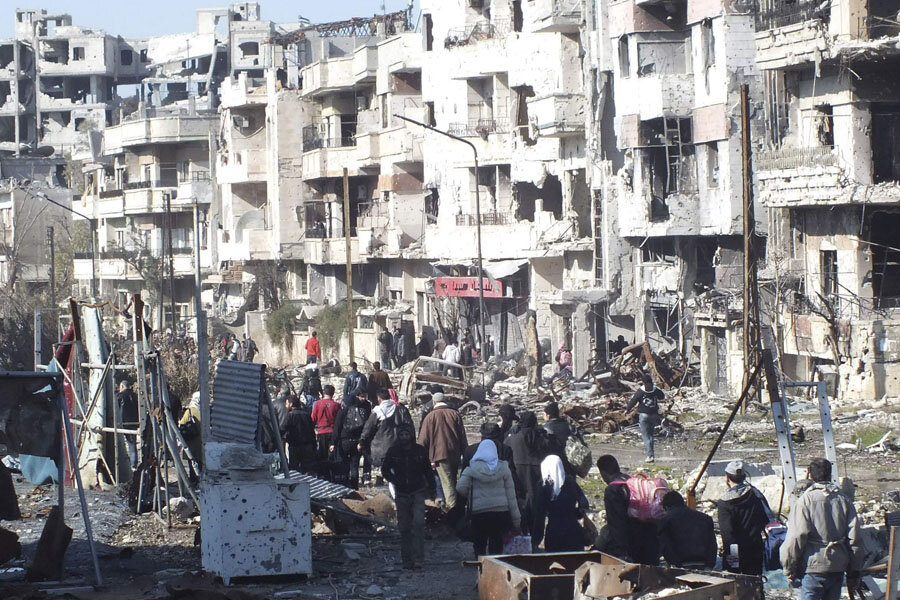Syria peace talks resume as fraught humanitarian cease-fire ends in Homs
Loading...
A daily roundup of terrorism and security issues
Peace talks between the Syrian government and the opposition resume again today in Geneva. But with the two sides still far apart on even the most basic issues, this round appears unlikely to show more progress than the first, which ended 10 days ago without any steps toward a negotiated solution.
The United Nations' special envoy to Syria Lakhdar Brahimi, who is mediating between representatives from Syrian President Bashar al-Assad's regime and the rebel forces arrayed against it, was scheduled this morning to meet with both groups separately in their hotels in Geneva, reports Agence France-Presse. It is unclear whether the two groups will meet face-to-face today, or how long the current round of talks is meant to last.
But the obstacles to any agreement between the two sides remain largely unchanged from two weeks ago, when the dialogue between the two sides was notable largely for its pervasive insults, Bloomberg notes. The sole concrete achievement, an agreement to enable the delivery of humanitarian aid and the evacuation of the most vulnerable civilians from stricken areas, fell far short in its implementation.
Mr. Assad insists that there can be no discussion of Syria's future, and that the only issue to be considered is how to deal with "terrorists." Some rebel factions do indeed have ties with Al Qaeda and other Islamist militant groups, but the Syrian regime has used the term broadly to describe all opposition groups.
For their part, the rebels insist that Mr. Assad's departure is a prerequisite of any future Syrian government, and say that plotting a course for a post-Assad Syria is a key goal for the talks.
The chasm between the two sides proved unbridgeable during the first round of talks, which one UN official lamented had not saved a single life, The Christian Science Monitor reported at their close. But the Monitor added that a handful of modest positives came out of the first round:
...[T]he Syrian opposition – despite its fractiousness and what some critics say is its lack of diversity (both in terms of gender and representation of the panoply of opposition forces) – is widely seen as having got a boost from both the Geneva talks and from the international Syria conference in Montreux, Switzerland, that preceded the Syrian dialogue.
The opposition’s chief representative, Ahmad Jarba, comes out of Switzerland a clear winner, say not just opposition representatives but US officials and some independent analysts. The president of the National Coalition for Syrian Revolutionary and Opposition Forces got high marks for his speech at the Montreux conference, which was carried in parts of Syria. ...
But perhaps most important, some say, is simply that the two sides sat down in the same room together. ...
“It is, I think, significant that throughout the week, the two sides agreed to stay in the room and, working with Lakhdar Brahimi, to talk to each other. That is not a small thing,” [a senior US official told journalists], “given that this conflict is now almost three years old."
However, the London-based Syrian Observatory for Human Rights, which monitors the conflict through a network of Syrian activists, the violence on the ground appears to have worsened since the first round of talks, the BBC reports.
The Observatory said that 304 people were killed across the country on Saturday, including more than 100 civilians.
On Sunday, opposition activists said at least 11 people were killed in the northern city of Aleppo when government helicopters dropped barrel bombs - crude weapons comprising cylinders packed with explosives and metal fragments - on rebel-held neighbourhoods.
Over the weekend, aid groups attempted to deliver food and other supplies to Homs, among the hardest hit in the war, under an agreement brokered with the Syrian government that also allowed for the evacuation of women, children, and older men. Residents have been trapped in the besieged city with little to no food or other daily essentials. But the cease-fire fell apart in execution, The New York Times reports.
A three-day humanitarian cease-fire in the Syrian city of Homs was supposed to be a small breakthrough, a moment of relief for civilians trapped in a grim civil war.
But mortar rounds and gunfire struck near aid convoys, damaging vehicles and leaving victims lying in the streets. Snipers fired on civilians as they fled their besieged neighborhood. Others refused to leave, fearing a massacre of those left behind. Limited food made it in, and some of the nearly 700 people who reached safety said they had been surviving on one meal a day and that some of their neighbors had resorted to eating grass.
Though few expect the international peace talks that resume in Geneva on Monday to end the war, many hope they will make life less brutal for ordinary Syrians by creating local cease-fires and opening up access to aid.
But what took place in Homs highlights the tremendous difficulties plaguing even modest humanitarian efforts, making it unlikely that the episode will emerge as a model to be repeated elsewhere.
And Reuters adds that the Syrian government came under fire in the Hague today for missing another deadline in the schedule to dismantle its chemical weapons, after failing to hand off critical chemical materials on Wednesday. Anti-Assad Western powers, led by the US, slammed Syria for the missed deadline, its second since the process began. Russia, Assad's key international backer, meanwhile defended the government and argued that transporting the materials through contested territory was proving difficult.
The next deadline falls Mar. 31, when most of the toxic substances are scheduled to be destroyed onboard a US naval vessel, the Cape Ray. But analysts warn that the divide between the US and Russia imperils the plan.
"The odds of Syrian compliance increase if Washington and Moscow speak with one voice, but that isn't happening at present," Amy Smithson, a chemical weapons expert at the U.S. Monterey Institute, a leading think tank, told Reuters.
"These two countries are both key to the potential success of chemical disarmament in Syria, not to mention a settlement to the overall conflict, so hopefully they will rapidly find a way to resolve this impasse," she said.








